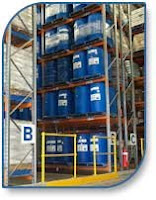Storage on Shelves
Hazardous Chemicals should be stored in chemical storage cabinets or laboratory cupboards. For chemicals that are kept on shelves or racks, they are subjected to the following restrictions:
- Shelving must be compatible with the goods stored;
- Shelving systems must be designed to hold the maximum holding capacity of the chemical containers;
- Incompatible chemicals should not be stored together on shelves. Keep a distance of 3 m between them. The space between can be used to store non-hazardous substances;
- Chemical packagings should not be kept on the floor;
- Solid chemicals should preferably be stored on upper shelves above liquid chemicals;
- Secondary containment is essential for large containers (eg. the 20 L waste cubes). It also makes sense to bund any container with capacity of 2.5 L and above. As a priority, all DGs of this size should be bunded;
- Shelves should have raised edges to reduce the likelihood of dislodging;
- The most dangerous chemicals should be stored at easily accessible heights (eg. 1.5 m from the floor);
- Chemicals should not be stored under direct sunlight; and
- Where refrigerated storage is required, do not use domestic refrigerators. Options include intrinsically safe refrigerators or domestic refrigerators that have been made electrically safe by a licensed electrician.
Storage in Cabinets
Each chemical storage cabinet must have a designated personnel responsible for its management. Their duties would include ensuring that:
- Appropriate emergency spill measures are in place;
- Emergency first aid is accessible and in working state;
- The storage location appears on the building manifest and on the annual notification to WorkCover;
- A risk assessment for storage of DGs is completed for the particular storage location; and
- Disposal of old and unwanted chemicals occurs regularly.

No comments:
Post a Comment